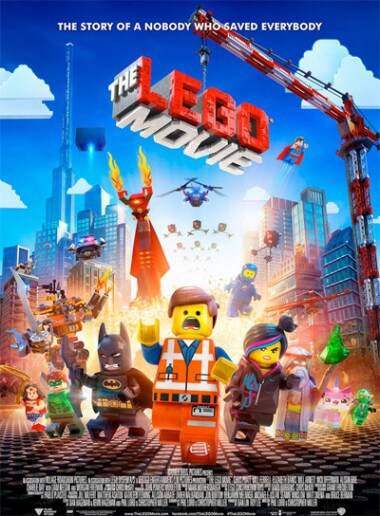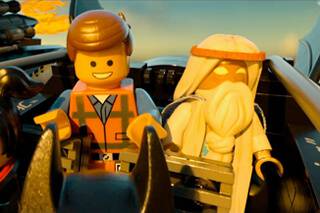‘The Lego Movie’ Review
 The cinema was packed with children and their parents, excitedly munching popcorn. We sat in the central row, in the middle of the aisle; the best seats in the house. After a surprisingly interesting ad campaign (mostly featuring Will Arnett’s Batman), we were eager to see just how Chris Miller and Phil Lord would treat one of the best loved toys of the past half a century, so the best seats in the house were a must! After all, Miller and Lord’s adaptation of the children’s book Cloudy With A Chance Of Meatballs was a resounding triumph of delicious visuals and humorous yet oddly relatable characters.
The cinema was packed with children and their parents, excitedly munching popcorn. We sat in the central row, in the middle of the aisle; the best seats in the house. After a surprisingly interesting ad campaign (mostly featuring Will Arnett’s Batman), we were eager to see just how Chris Miller and Phil Lord would treat one of the best loved toys of the past half a century, so the best seats in the house were a must! After all, Miller and Lord’s adaptation of the children’s book Cloudy With A Chance Of Meatballs was a resounding triumph of delicious visuals and humorous yet oddly relatable characters.
It’s hard to believe that the film isn’t stop-motion; Every brick, and every movement feels as though an expert animator had spent hours positioning the – usually limited – Lego figures. Only if you really paid attention would you notice the computer-generated trickery at play that allowed minute movements such as head-bobbing and hand closing, but the film easily carried a critical eye away from such things. As natural as the movement seemed, it was an experience far from sitting around watching a bunch of bricks. My eyes were constantly noticing background characters performing slapstick routines, or behaving out of the ordinary. The feast of cameos and background detail alone warrants a second viewing of the film to make sure you get as much of the well-considered humour as possible.
 Thankfully, the core of The Lego Movie was not in advertising to children (who might pester their parents to buy the popular Danish brick products); at the center of the film was a heartfelt story led by the lead character Emmet (played by Parks and Recreation‘s Chris Pratt), as he was forced to find his individuality in a world where everything follows the instructions. The rest of the cast (including talents such as Morgan Freeman, Liam Neeson, Community‘s Alison Brie, and It’s Always Sunny In Philadelphia‘s Charlie Day) acted as the support to Emmet’s journey, but fleshed it out with enjoyable portrayals that are oddly unforgettable (for people constructing of 8 or so colourful blocks locked together). Popular franchises with existing Lego sets are given good representation, particularly DC Comics’ heroes. These included Wonder Woman (How I Met Your Mother‘s Cobie Smulders), Superman (Channing Tatum), and Aquaman (Jonah Hill). Batman and Aquaman in particular are used as a device for the film to distance the Lego characters from those in their own established canon. For example: witty allusions to Batman’s complacency at being the constant fan-favourite superhero (as evidenced by the past decade of critically acclaimed films and videogames), complacency that you wouldn’t see in the Batman comics. As far as licensed brands go, there is a particular Lucasfilm property that shows up with perhaps one of the best cameos in film history that I won’t spoil for you.
Thankfully, the core of The Lego Movie was not in advertising to children (who might pester their parents to buy the popular Danish brick products); at the center of the film was a heartfelt story led by the lead character Emmet (played by Parks and Recreation‘s Chris Pratt), as he was forced to find his individuality in a world where everything follows the instructions. The rest of the cast (including talents such as Morgan Freeman, Liam Neeson, Community‘s Alison Brie, and It’s Always Sunny In Philadelphia‘s Charlie Day) acted as the support to Emmet’s journey, but fleshed it out with enjoyable portrayals that are oddly unforgettable (for people constructing of 8 or so colourful blocks locked together). Popular franchises with existing Lego sets are given good representation, particularly DC Comics’ heroes. These included Wonder Woman (How I Met Your Mother‘s Cobie Smulders), Superman (Channing Tatum), and Aquaman (Jonah Hill). Batman and Aquaman in particular are used as a device for the film to distance the Lego characters from those in their own established canon. For example: witty allusions to Batman’s complacency at being the constant fan-favourite superhero (as evidenced by the past decade of critically acclaimed films and videogames), complacency that you wouldn’t see in the Batman comics. As far as licensed brands go, there is a particular Lucasfilm property that shows up with perhaps one of the best cameos in film history that I won’t spoil for you.
 The aforementioned protagonist, Emmet, is himself an ‘everyman’ trope; Emmet fits into conventional everyday life as satirically as possible. The first portion of the film could be considered as a little too heavily critical of corporations, and too reliant on satirizing today’s society, but this is easily forgiven by how continual the jokes come and how consistently they make you genuinely laugh. Ultimately the film elicits feelings of nostalgia and plays this to its strength with the surprise moral twist that comes into play in the final act. Children will find the film as engrossing and spellbinding as any universally cherished animation, but I feel it is parents who have been through the experience of inventing with their toys so many years ago who will be hit with the strongest emotions. Will Ferrel’s antagonist, Lord Business, is a wonderfully written ‘bad-guy’ (as intentionally stereotypical as they come) that is as crucial to the film’s need to entertain children as he is to the film’s desire to make parents want to engage with their children’s imaginations.
The aforementioned protagonist, Emmet, is himself an ‘everyman’ trope; Emmet fits into conventional everyday life as satirically as possible. The first portion of the film could be considered as a little too heavily critical of corporations, and too reliant on satirizing today’s society, but this is easily forgiven by how continual the jokes come and how consistently they make you genuinely laugh. Ultimately the film elicits feelings of nostalgia and plays this to its strength with the surprise moral twist that comes into play in the final act. Children will find the film as engrossing and spellbinding as any universally cherished animation, but I feel it is parents who have been through the experience of inventing with their toys so many years ago who will be hit with the strongest emotions. Will Ferrel’s antagonist, Lord Business, is a wonderfully written ‘bad-guy’ (as intentionally stereotypical as they come) that is as crucial to the film’s need to entertain children as he is to the film’s desire to make parents want to engage with their children’s imaginations.  I am sure most of the laughter from the audience came from the adults who were treated to a wealth of pop culture references and familiar themes. Why wouldn’t the film try to relate to the adults? They’re the ones with money burning in their wallets.
I am sure most of the laughter from the audience came from the adults who were treated to a wealth of pop culture references and familiar themes. Why wouldn’t the film try to relate to the adults? They’re the ones with money burning in their wallets.
On leaving the cinema (finding it hard to settle on a single ‘best-bit’ to rave about with my fellow cinema-goers), I struggled to resist the compulsion to peruse the Lego sets in my local toy shop, yet not once did it feel like the film was trying to advertise to me; this is perhaps the film’s greatest triumph. The Lego Movie is an excellent film in its own right, that uses Lego perfectly as a medium that fits, like two brick-like objects that are designed to fit together in a simple and structurally sound way.
The Lego Movie is released in cinemas throughout the UK on February 14th

